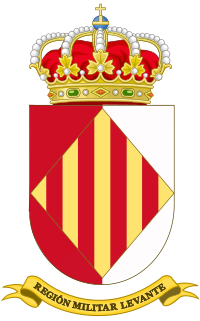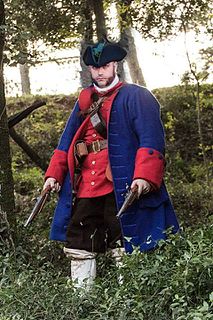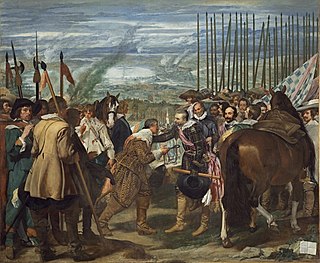 W
WThe aduaneros were a special military force created by Tomás de Zumalacárregui during the First Carlist War. They were entrusted with the levying of revenue for various consumer goods. During the first years of the war, they prohibited the export and import of goods to isolated barracks and fortified villages that had sided with the Liberal (Isabeline) cause.
 W
WThe Army of Arauco was a professional army in the service of the kings of Spain that was based in Spanish-Mapuche frontier, south-central Chile, during the 16th to 19th centuries. It was notable for being a rare example of a standing army in the Americas. The army was established after the disastrous Destruction of the Seven Cities (1598–1604) to fight in the Arauco War against anti-Spanish Mapuche coalitions. The army was financed by silver from Potosí, in a payment called Real Situado.
 W
WThe Army of Flanders was a multinational army in the service of the kings of Spain that was based in the Spanish Netherlands during the 16th to 18th centuries. It was notable for being the longest-serving standing army of the period, being in continuous service from 1567 until its disestablishment in 1706. In addition to taking part in numerous battles of the Dutch Revolt (1567–1609) and the Thirty Years' War (1618–1648), it also employed many developing military concepts more reminiscent of later military units, enjoying permanent, standing regiments (tercios), barracks, military hospitals and rest homes long before they were adopted in most of Europe. Sustained at huge cost and at significant distances from Spain, the Army of Flanders also became infamous for successive mutinies and its ill-disciplined activity off the battlefield, including the Sack of Antwerp in 1576.
 W
WAn askari was a local soldier serving in the armies of the European colonial powers in Africa, particularly in the African Great Lakes, Northeast Africa and Central Africa. The word is used in this sense in English, as well as in German, Italian, Urdu and Portuguese. In French, the word is used only in reference to native troops outside the French colonial empire. The designation is still in occasional use today to informally describe police, gendarmerie and security guards.
 W
WThe Blue Division was a unit of volunteers from Francoist Spain within the German Army (Wehrmacht) on the Eastern Front during World War II. It was officially designated the Spanish Volunteer Division by the Spanish Army and 250th Infantry Division by the Germans.
 W
WThe Blue Squadron was a generic name given to the group of volunteer pilots and ground crews recruited from the Spanish Air Force that fought in the side of Germany on the Eastern Front, during the Second World War. The "Blue Patrol" was a counterpart offered by Franco to Nazi Germany for its help with the Condor Legion during the Spanish Civil War.
 W
WDuring the Spanish–American War of 1898, Cámara's Flying Relief Column was a naval task force of Spain's most powerful warships, under the command of Rear Admiral Manuel de la Cámara, tasked with relieving Spanish forces in Manila after the defeat of Spanish Pacific Squadron under Admiral Patricio Montojo y Pasarón by the American Asiatic Squadron under Commodore George Dewey in the Battle of Manila Bay on May 1, 1898. The Spanish fleet, consisting of the battleship Pelayo, armored cruiser Emperador Carlos V, auxiliary cruisers Patriota and Rapido, destroyers Audaz, Osado, and Prosepina, and transports Buenos Aires and Panay, left Spain in June 1898. The squadron was far more powerful than that commanded by Dewey, which only consisted of four protected cruisers and two gunboats. The monitor USS Monterey had been ordered from the U.S. to the Philippines, and departed on 11 June.
 W
WChapelgorris, also called Peseteros, were a type of volunteer unit during the First Carlist War, raised at the beginning of the war in the province of Guipúzcoa. They fought against the Carlists.
 W
WThe Division of the North was a 19th-century Spanish infantry division.
 W
WThe Royal Guard is an independent regiment of the Spanish Armed Forces that is dedicated to the protection of the King of Spain and members of the Spanish Royal Family. It currently has a strength of 1500 troops. While the guard does participate in parades and other ceremonial events, it is a fully functional combat unit. Its members are recruited from the ranks of all three branches of the Spanish Armed Forces and receive the same combat training as regular soldiers.
 W
WThe Guardia Mora, officially the Guardia de Su Excelencia el Generalísimo was Francisco Franco's personnel ceremonial escort. it was formed in February 1937 from personnel drawn from the Guardia Civil in Tétouan and the II Tabor of Grupo de Regulares de Tetuan No.1. Their white and red hooded cloak, based on the chilaba, was worn over the white parade uniform of Regulares officers.
 W
WThe Guías de Navarra were a Carlist battalion of the First Carlist War, created by Zumalacárregui in 1834.
 W
WThe III Military Region also known as the Captaincy General of Valencia, was a historical subdivision of Spanish territory from the military point of view - a military district, from 1939 - 1984. Its jurisdiction extended through the provinces of the current Valencian Community, and the Murcia. The region's headquarters was located in Valencia.
 W
WThe Spanish Naval Infantry is the naval infantry unit of the Spanish Navy responsible for conducting amphibious warfare by utilizing naval platforms and resources. The Marine Corps is fully integrated into the Armada's structure.
 W
WJinete is Spanish for "horseman", especially in the context of light cavalry.
 W
WThe Spanish Maquis were Spanish guerrillas exiled in France after the Spanish Civil War who continued to fight against Francoist Spain until the early 1960s, carrying out sabotage, robberies, occupations of the Spanish embassy in France and assassinations of Francoists, as well as contributing to the fight against Nazi Germany and the Vichy regime in France during World War II.
 W
WMiquelets or Micalets were irregular Catalan and Valencian mountain light troops. They enjoyed a certain prominence in the wars in the Iberian Peninsula during the 17th and 18th centuries, and in peace seem to have on occasion plundered travellers.
 W
WThe Monteros de Espinosa are the oldest Bodyguard unit of Royal Guards in Europe. Founded by the Counts of Castile around the year 1006 and kept in service by the Castilian Sovereigns and posterior Dynasties that inherited their Kingdoms and united with. It is still part of the Spanish Guardia Real.
 W
WThe Musical Unit of the Spanish Royal Guard is the official music service of the Spanish Royal Guard of the Spanish Armed Forces that is dedicated to providing ceremonial honours and music to the King of Spain, the Spanish Royal Family, and public officials. The musical unit is one of many battalion sized units in the regiment, with over 100 professional musicians in its ranks who are chosen from the non-commissioned officers of the Military Music Corps. It is one of the more senior and representative bands in the Spanish Armed Forces, with its repertoire covering a wide range of Army, Navy and Air Force music. The entire unit is currently under the baton of the conductor of the Military Band of the Royal Guard, Colonel Musician Enrique Damián Blasco Cebolla.
 W
WThe Fuerzas Regulares Indígenas, known simply as the Regulares (Regulars), are volunteer infantry units of the Spanish Army, largely recruited in the cities of Ceuta and Melilla. Consisting of indigenous infantry and cavalry recruited in Spanish Morocco, forming part of the Army of Africa and officered by Spaniards, these troops played a significant role in the Spanish Civil War (1936–39).
 W
WThe Spanish Army of the Peninsular War refers to the Spanish military units that fought against France's Grande Armée from 2 May 1808 (the Peninsular War began 27 October 1807 with the Franco-Spanish invasion of Portugal) to 17 April 1814) a period which coincided with what is also termed the Spanish War of Independence.
 W
WThe Spanish Legion, informally known as the Tercio or the Tercios, is a unit of the Spanish Army and Spain's Rapid Reaction Force. It was raised in the 1920s to serve as part of Spain's Army of Africa. The unit, which was established in January 1920 as the Spanish equivalent of the French Foreign Legion, was initially known as the Tercio de Extranjeros, the name under which it began fighting in the Rif War of 1920–1926. Although foreign recruitment spans the Spanish-speaking nations, the majority of recruits are Spaniards. Over the years, the force's name has changed from Tercio de Extranjeros to Tercio de Marruecos, and by the end of the Rif War it became the "Spanish Legion", with several "tercios" as sub-units.
 W
WA tercio or tercio español was a type of Spanish pike and shot infantry unit known for its numerous victories on the battlefields of Europe during the 16th century and the first half of the 17th century, and was a major development of early modern combined arms warfare.
 W
WThe Tercio of Sicily is one of the tercios that were created by a 1534 decree of Charles V, Holy Roman Emperor. Since the 18th century, the Spanish army has maintained the tradition of this tercio in its regiments.
 W
WThe Tiradores de Ifni were volunteer indigenous infantry units of the Spanish Army, largely recruited in the enclave of Ifni The tiradores were originally recruited from the Spanish Morocco, forming part of the Army of Africa and mostly officered by Spaniards, these troops played a role in the Spanish Civil War (1936–39).
 W
WThe Unidad de Operaciones Especiales was the elite special operations force of the Spanish Navy and marines from 1967 to 2009. In June 2009, the unit was absorbed into the newly formed Naval Special Warfare Force. The UOE, which was formerly garrisoned in the Tercio de Armada in San Fernando, Cádiz, operated under the direct control of the Admiralty and Naval Special Warfare Command. It was thought to comprise approximately 100 men organized into three Operational Teams (Estoles) as well as command and support personnel. The unit "has long been one of Europe's most respected special forces."